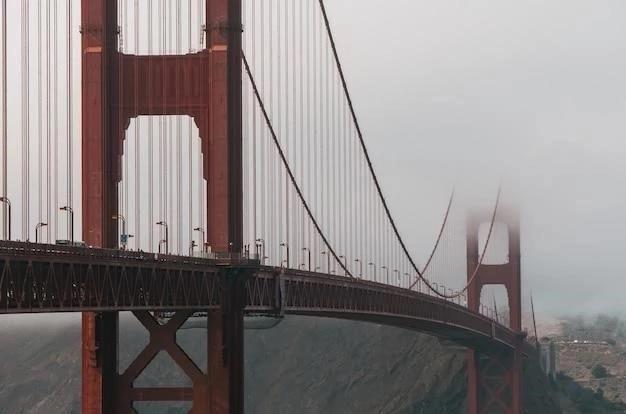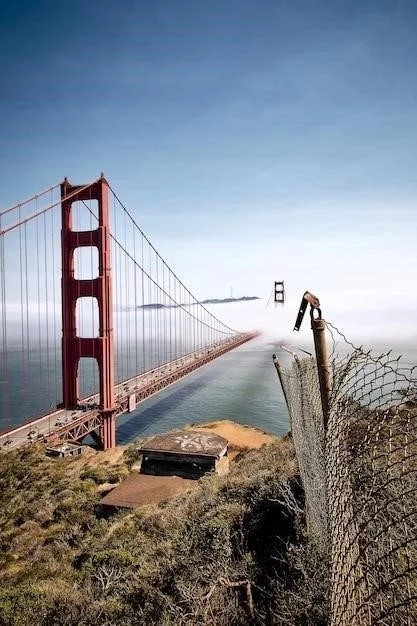The Golden Gate Bridge is an iconic symbol of San Francisco and one of the most recognizable bridges in the world․ Its vibrant orange color, towering towers, and graceful suspension cables have captivated peoples imaginations for generations․ This article delves into the history, design, construction, and enduring legacy of this engineering marvel․

A History Forged in Necessity
Before the Golden Gate Bridge existed, the only way to cross the Golden Gate Strait, the mile-wide channel separating San Francisco Bay from the Pacific Ocean, was by ferry․ As San Francisco grew in the late 19th and early 20th centuries, the ferry system became increasingly congested and inefficient․
The idea of building a bridge across the Golden Gate had been around since the 1870s, but it was considered technologically impossible and financially impractical at the time․ However, by the 1920s, advances in engineering and a growing public demand for a more efficient transportation link led to renewed interest in the project․

A Vision Takes Shape
In 1923, the California legislature passed a bill authorizing the creation of the Golden Gate Bridge and Highway District, a special district tasked with financing, designing, and constructing the bridge․ The district hired Joseph Strauss, a renowned bridge engineer, as the chief engineer․
Strausss initial design for the bridge was met with resistance from various groups, including architects who found it aesthetically unpleasing and the War Department, which was concerned about its potential impact on navigation․ After years of negotiations and design revisions, a final design was approved in 1930․
Construction: A Triumph of Engineering
Construction of the Golden Gate Bridge commenced on January 5٫ 1933․ The project was a massive undertaking٫ requiring innovative engineering solutions and the labor of thousands of workers․
Building the Foundations
The first step was to build the bridges massive concrete anchorages and piers․ The south pier, located in San Francisco, was built on land․ However, the north pier had to be built in the middle of the Golden Gate Strait, which presented significant challenges․ Workers had to construct a huge cofferdam, a watertight enclosure, around the pier site to pump out the water and create a dry working environment․
Erecting the Towers
With the foundations in place, the next step was to erect the bridges two iconic towers․ Each tower is 746 feet tall and made of steel․ To build them٫ workers used a giant creeper crane that climbed up the towers as they were assembled٫ adding new sections of steel from the top․
Spinning the Cables
The Golden Gate Bridges suspension system consists of two main cables that run over the tops of the towers and are anchored at each end․ Each cable is 7,650 feet long and 3 feet in diameter․ They were made by spinning individual steel wires together using a traveling pulley system that moved back and forth between the towers․
Suspending the Roadway
Once the cables were in place, workers began attaching the vertical suspender ropes that would support the bridges roadway․ The roadway is made of steel and concrete and is 6 lanes wide․ It was assembled in sections on land and then hoisted into place by cranes․
A Bridge is Born
After four years of construction and overcoming numerous challenges, the Golden Gate Bridge was completed in May 1937․ The total cost of the project was $35 million, which was significantly less than originally estimated․ On May 27, 1937, the bridge was opened to pedestrian traffic, and the following day, it was opened to vehicular traffic․
The Golden Gate Bridge Today: An Enduring Legacy
In the decades since its completion, the Golden Gate Bridge has become one of the most recognized and photographed landmarks in the world․ It is visited by millions of tourists each year and continues to serve as a vital transportation link for the San Francisco Bay Area․
The bridges distinctive International Orange color, chosen for its visibility in fog, has also become iconic․ It is constantly being maintained by a team of painters who touch up the paintwork to protect it from the corrosive effects of salt air and fog․

Conclusion: A Testament to Human Ingenuity
The Golden Gate Bridge stands as a testament to human ingenuity and our ability to overcome seemingly insurmountable challenges․ It is a symbol of progress, innovation, and the enduring power of dreams․ As it continues to stand for generations to come, it will forever inspire awe and wonder in all who behold it․

The Golden Gate Bridge: Beyond the Icon
While the Golden Gate Bridges aesthetic appeal is undeniable, its significance extends far beyond its visual impact․ The bridge represents a pivotal moment in engineering history, pushing the boundaries of what was considered possible in the early 20th century and setting new benchmarks for suspension bridge design and construction․
Engineering Triumphs:
Several key innovations contributed to the bridges success:
- Deepwater Foundations: Constructing the north pier in the turbulent waters of the Golden Gate Strait was a monumental feat․ The innovative use of a cofferdam, a massive watertight structure, allowed engineers to create a dry working environment amidst challenging conditions․
- Cable Spinning Technology: The bridges two main cables, each over 7,000 feet long and containing thousands of individual wires, were spun on site using a complex system of pulleys and machinery․ This process, while time-consuming, allowed for the creation of cables with immense strength and flexibility․
- Wind Resistance Design: The Golden Gate Strait is known for its strong winds․ To ensure the bridges stability, engineers incorporated aerodynamic design principles, including a streamlined deck and truss system, effectively mitigating the impact of wind forces․
A Legacy of Innovation:
The Golden Gate Bridges impact on bridge design and construction is immeasurable․ The innovative techniques and engineering solutions employed during its construction paved the way for the development of longer, stronger, and more ambitious suspension bridges worldwide․ Its influence can be seen in structures like the Verrazano-Narrows Bridge in New York City and the Akashi Kaikyō Bridge in Japan, both of which surpassed the Golden Gate Bridge in length but built upon its foundational principles․
Enduring Symbolism:
Beyond its engineering significance, the Golden Gate Bridge has taken on profound cultural and symbolic meaning; It represents the spirit of innovation and progress, a testament to human ingenuity and determination․ Its iconic image continues to inspire artists, writers, and dreamers, serving as a beacon of hope and a reminder of the power of human ambition․
As the Golden Gate Bridge enters its ninth decade, it stands as a testament to the enduring legacy of engineering excellence․ It is a bridge that connects not just two pieces of land, but also the past and the present, inspiring future generations to push the boundaries of what is possible․










